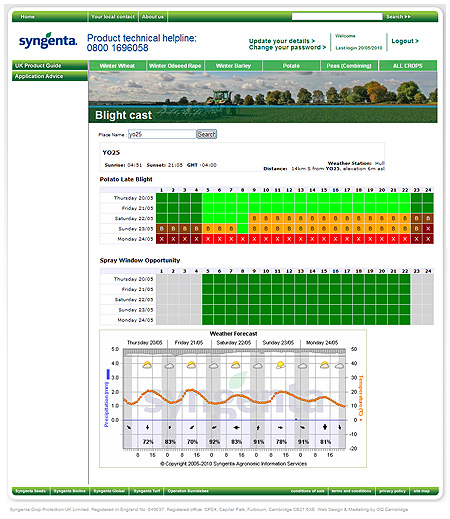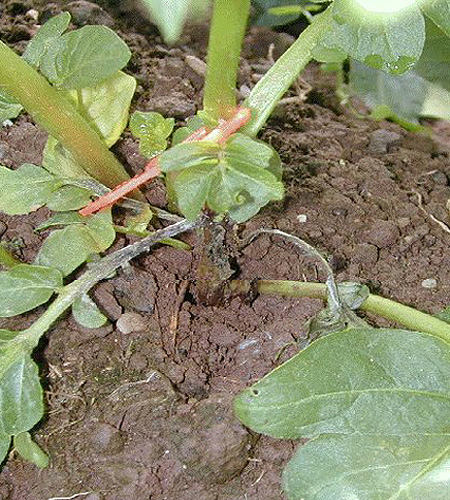
Potato crops are set to be hit by a high blight risk early next week, according to forecasts on the Syngenta BlightCAST website. Parts of Yorkshire and the eastern counties are predicted to experience successive near miss periods over Saturday and Sunday, with a blanket Full Smith period on Monday (24 May 2010).
"With this season’s delayed planting, cold soils slowing emergence and plummeting night temperatures scorching leaves, many crops are only just getting going," reports Mark Bullen of Syngenta. "New growth is extremely susceptible to blight infection at this early timing," he adds.
"It is imperative that growers start blight programmes from the first risk of infection, and maintain protection right through the season," he advises. "Any infection that gets in now will act as a reservoir of disease, which could quickly spread through the crop whenever weather conditions allow or if blight fungicide protection slips."
Mr Bullen advocates that, where growers see a high risk period, they should start with an application of Shirlan as soon as possible, to prevent initial blight infection and stop movement of blight zoospores through the soil. "With this early season high risk, the following use of Revus through rapid canopy development will be even more important to protect new leaf growth from infection."

Syngenta BlightCAST uniquely combines weather forecasts with detailed blight models, to give growers a five-day local prediction of conditions conducive to disease and the risk of infection occurring. The system, which is available free for all growers and agronomists registered on the Syngenta website – www.syngenta-crop.co.uk – has proven extremely popular and robust in helping growers tailor their fungicide application timing and appropriate product selection.
BlightCAST also includes a practical forecast of spraying opportunities over the coming five days, enabling growers to schedule applications more accurately to counter potential disease risk.
West-midlands based agronomist, Mark Taplin, who advises growers of around 1000 hectares of processing crops, welcomes the fact that BlightCAST t is easily interpreted at a glance and provides a five-day forecast of blight risk to help forward planning and decision making.

"For practical purposes, to help with product selection and scheduling, BlightCAST quickly and succinctly gives us all the information we need; the results are presented as a highly visual, colour-coded ’high, medium or low’ risk prediction," he reports. "We get a good idea of what is coming over the next few days, which can help with decisions over product selection and spray timing accordingly."
Whilst the BlightCAST web site is updated throughout the day for any changes in local weather conditions and can be accessed by registered growers at any time, Mr Taplin tends to use the system’s five-day forecast twice a week; typically on a Monday morning to plan the week’s activities, and again on a Thursday to see what’s coming over the weekend.
Last year, for example, he recalls that the BlightCAST forecasts gave growers greater reassurance that blight pressure was low early in the season, with opportunities to extend spray intervals. But when the pressure came later in the season they were adequately warned and able to step up the blight programmes accordingly.
"Where we can see a high risk period coming and there are limited spraying opportunities, for example, then its imperative to get on some strong protection with good rainfast properties, such as Revus," he advises. Mr Taplin does not consider that BlightCAST will typically reduce the number of blight sprays over the course of the season, "but it does help us to make more proactive decisions and achieve better application timing with the most appropriate product choices, which ultimately should give us more effective blight control."
BlightCAST is available free to all growers and agronomists registered on the Syngenta website: www.syngenta-crop.co.uk
